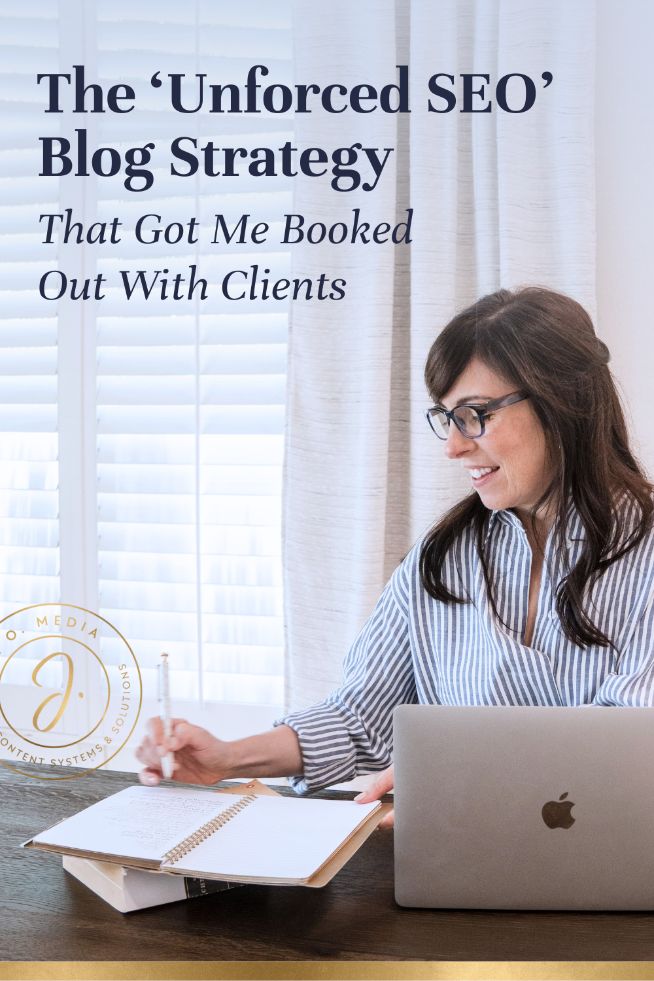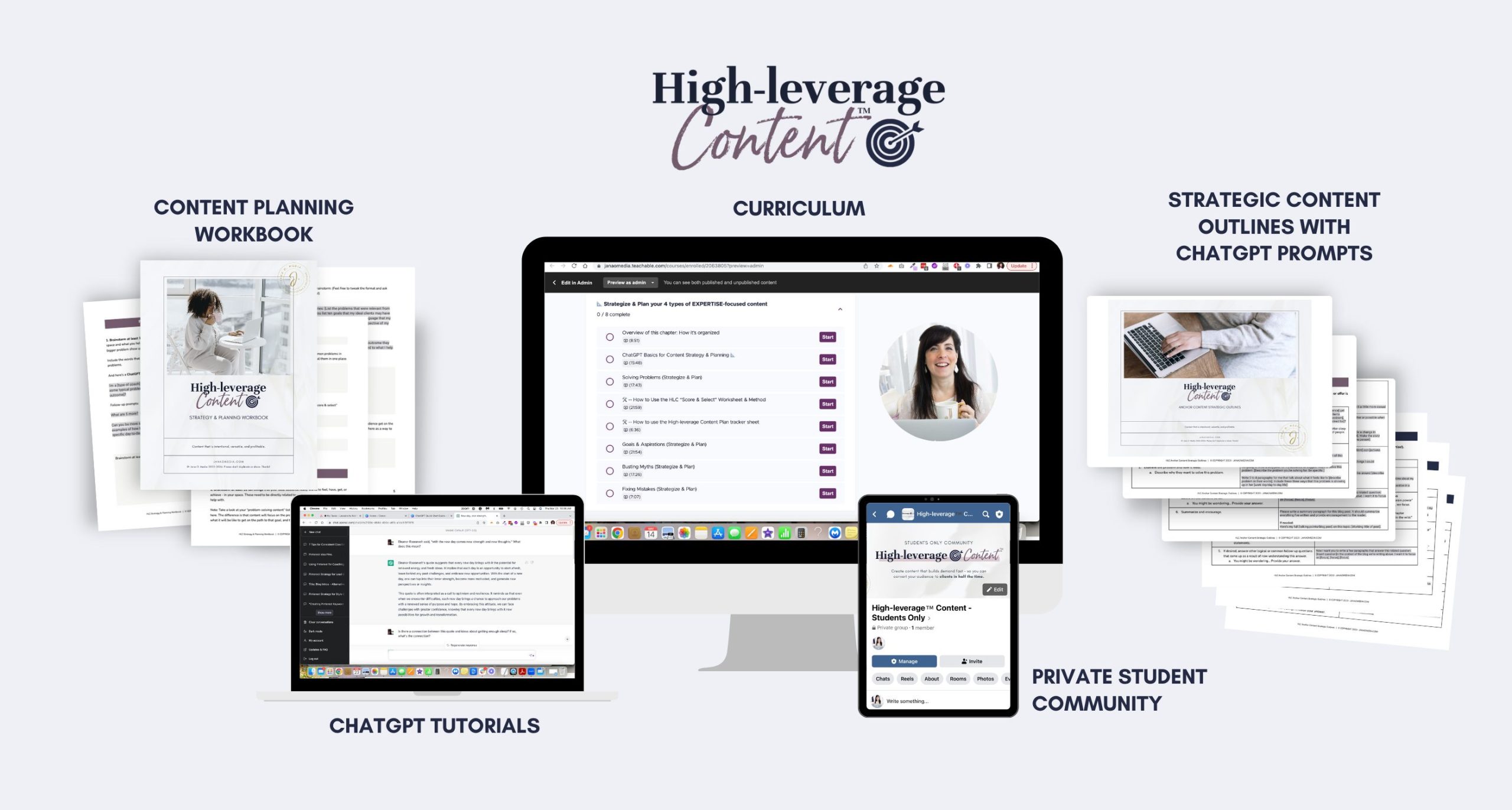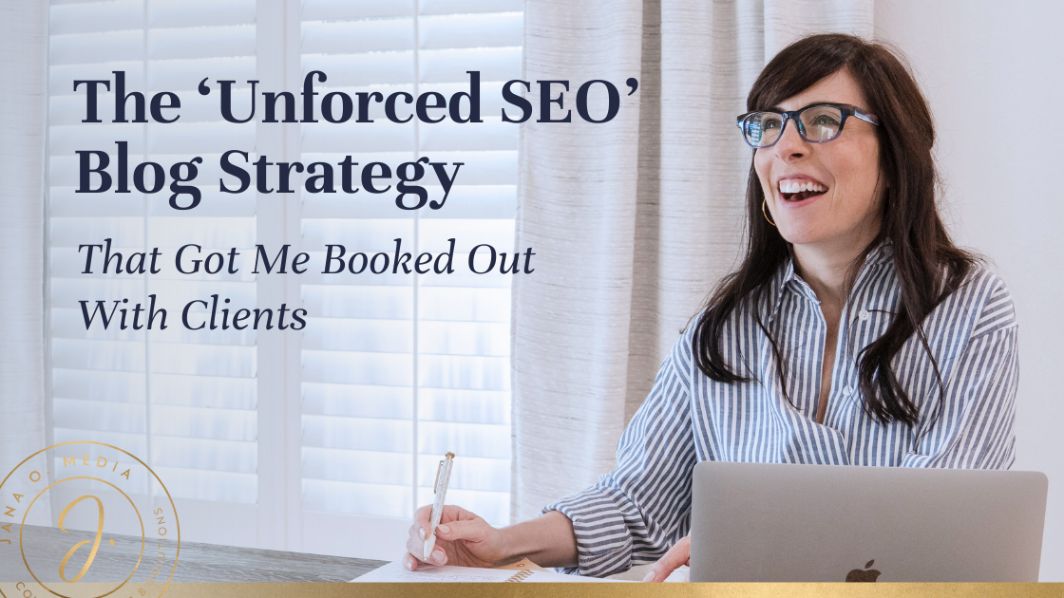Let’s see if this sounds familiar…
You’re a coach or service provider and you want to start a blog to attract clients.
So you sit down to write about a topic you know your ideal clients need to understand, to feel ready to work with you.
The first few hundred words flow out. It’s going well! 💪🏼
But then you remember:
“Oh shoot. 🫤 Someone told me I should do SEO if I’m going to have a blog.”
So you open a new tab, fall down a rabbit hole looking for a keyword that fits what you want to write… and suddenly the post feels a lot harder to write.
It starts sounding robotic. You second-guess your angle. You try to cram in a phrase that doesn’t fit.
Eventually, the Google doc you’re working in just gets abandoned — and instead of hitting publish on a blog post, you slap up a quick Instagram post and call it a day. 🤷🏻♀️
Your post remains half-written, never to see the light of day.
Your blog never becomes the powerful client-converting asset that it could have been… And you just keep focusing your attention on social media.
😏
But wait…
Let’s rewind that story and write a different ending, shall we?
⬅️ ⬅️ ⬅️ ⬅️ ⬅️ ⬅️ ⬅️ ⬅️ ⬅️ (Squeaky tape rewinding sound)
This time, you write the post based on what your audience actually needs to hear, to feel ready to buy. And you don’t worry about keywords for now.
You publish it. You share it.
Three people reach out to inquire about your services or coaching.
You sign 2 of them as new clients. 💃🏻
And since you now have a blog post that’s an evergreen asset, you can use it again and again to convert clients.
And… here’s the kicker… over time, Google ends up indexing your blog post favorably anyway 😲because search engines like to show content that is written by experts, for real humans.
Boom! 👆🏻That’s what happens when you stop forcing SEO — and start practicing what I call ‘Unforced SEO.’
In this blog post, I’m spilling everything about this ‘Unforced SEO’ strategy… I’ll show you how you can have a powerful, evergreen blog that sells your coaching or service-based offers — without chasing keywords or gaming algorithms.
I’ll cover:
- What is Unforced SEO?
- How my blog got me completely booked out as a DFY service provider — without an intentional SEO plan.
- The SEO secret that no one talks about, but the cool kids all know about 😉
- What makes ‘Unforced SEO’ different vs. traditional SEO approaches
- What results service providers and coaches get from adopting ‘Unforced SEO’
- Why it’s crucial to remember that “You’re not a blogger. You’re a business owner with a blog.”
- Steps you can take today to start writing blog posts that get you clients now, and rank on Google naturally
Ready? It’s going to be juicy!
Let’s start with a basic definition: 👇
What is ‘Unforced SEO?’
In a nutshell: It’s the idea that, instead of trying to write for keywords when you’re starting a blog, it’s better to simply write what your audience needs to hear, learn, and understand more deeply, — to be ready to buy.
This way you don’t get frustrated or lose inspiration — and stop writing.
And when you choose topics that feel highly relevant to your people, then those posts will naturally be favored by Google over time anyway — and by any search engines…
Because they all prioritize content written for real humans with real-world expertise — about things real humans want, struggle with, and believe.
Unforced SEO is part of how I teach blog writing inside my program, High-leverage Content.
It’s also how I did blog writing for 8+ years and got booked out without obsessing over keywords. Which brings me to that story…
How the “Unforced SEO” blog strategy got me booked out with clients
There’s a reason why I subscribe to this idea — and what I teach online coaches and service providers to write blog posts this way inside High-leverage Content.
It’s because this is how I ended up signing lots of clients with my blog AND getting ranked on Google page #1.
I got totally booked out as a DFY service provider and coach (and I made a sh*t-ton of money! 🤣) — without doing SEO the “official” or “forced” way.
That’s right. I did NOT start my blog by obsessing over keywords, writing “ultimate guides,” or using Yoast or Ubersuggest or any other expensive tool.
Here’s a basic timeline of what unfolded for me, that got my offers booked out solid:
📆 Year 1: I just wrote blogs about what my future clients needed.
I simply blogged about what I wanted them to know about Pinterest marketing (that was my thing for 7+ years!). ZERO thought to SEO.
I didn’t try to fit my topics or my blog structure around keywords. I focused on saying the right things, answering the real questions that were in their brains, and being persuasive.
I wanted people to land on my site, skim a few blogs, and instantly feel like:
✔️ I get what they want from their marketing
✔️ Pinterest can help them get it
✔️ I’m the one who knows how to do Pinterest right – for their type of business.
I just shared my blog posts — and they brought me clients. (Lots of them. I doubled my prices twice that year! 😲)
📆 Year 2: I kept blogging and increased my income by 600%.
Still no actual SEO strategy. Just sharper messages, writing for conversion, and sharing results from the clients my blog had already converted.
And I kept sharing my new and old blog posts.
I doubled my prices again and tripled my number of clients. It was a wild couple of years — and I made a mint. 💰💰💰
📆 Around the end of Year 2: I noticed some posts were ranking on Google. Cool! 😎
That happened naturally — because my content was genuinely helpful and deeply aligned with what people were wanting to know and searching for. And Google could tell I was an authority on the topic.
I wasn’t chasing keywords. I was answering real questions with real expertise.
That same year, I became friends with an SEO expert (the lovely Cinthia of Digital Bloom IQ!) who showed me how to tweak my already-ranking content to bump it up.
It worked. Some of those page 4 and page 7 posts started showing up on page 1.
And I added a course + intensive to my offers — which also sold out, largely from blog traffic.
📆 Years 3 – 5: This is when I finally layered in more intentional SEO — on top of content that already worked.
Some posts I wrote to convert. Others, I wrote based on a specific SEO phrase I wanted to rank for. But by then, I already had a strong foundation of conversion-driven content — and clients to show for it.
So here’s the BIG takeaway from my story:
Today, I have blog posts that rank on Google. They bring me consistent traffic and grow my email list on autopilot, which is awesome. But I didn’t try to “do SEO” until Years 2 and 3.
And…
👉🏼 If I had believed the myth that I needed to learn SEO before I started blogging, I NEVER would have started.
I would’ve gotten overwhelmed, confused… and probably just ghosted the idea of a blog.
I might’ve fallen back on social media and stayed on that treadmill. My list would’ve grown slowly (if at all). I might have let my client roster (and my income) stay inconsistent.
But I didn’t. I blogged. 💪🏼
I stood out.
I built trust and demand the long-form way.
And I reaped the rewards of the overall strategy that I now teach inside High-leverage Content.
This is the beauty of Unforced SEO: You don’t need to “game” the algorithm or stuff keywords in headings. You just need to write what your people actually need to hear to be ready to hire you.
Up next, I’m tattling on the industry, and telling you a *huge* SEO secret that no one else is telling the newbies… 😲
(Pssssst…. You can 📌 pin this article for reference to your “Pinterest marketing” board:)

The SEO secret no one talks about: Everyone who ranks on Google now, started this way.
The way the online business community talks about SEO… They make you think that people who rank on Google now, wrote for keywords out of the gate…
And they make new blog writers feel like something is wrong with *them* if they don’t start with a perfect keyword plan. (And that blogging will be a waste of time if you don’t.)
But I’m here to tell you that that’s just not how it happens in real people’s businesses.
In addition to my own experience using this ‘Unforced SEO’ approach (detailed above), I have spoken to *dozens and dozens* of coaches and service providers about this, over the years… My friends, collaboration partners, clients, students, mentors…
And literally everyone I know who now ranks on Google started this way.
They didn’t say, “I want to start a blog to get clients!” and start listing keywords to write about.
They wrote what their audience needed to know about their niche and about their offers. And over time, Google indexed their blog posts.
It’s true… Ask your friends! 🙂
Okay… Next up, I want to answer some frequently asked questions that I get from coaches and service providers, about this idea of ‘Unforced SEO.’ We’ll start with…
Q: What makes this different from a traditional SEO approach?
I think the best way to tease out the difference is to address what we DON’T do, when we are writing blog posts the ‘Unforced SEO’ way…
{1} You don’t make a list of keywords and try to write around them – which feels heavy for most service providers and coaches. (And keeps them blog-less and dependent on social media.)
{2} You don’t focus on writing “ultimate guides” that just give information, but don’t bring your reader down the path toward buying your paid offers. (Some tips and tricks is good on your blog, but there’s a natural tension between “giving it all away for free” in these ultimate guide-style posts vs. strategically sharing in a way that gives value, but also sets up a sale.)
{3} You don’t worry about whether the things you know your audience needs (to be ready to buy) have high enough search volume. This trips up so many people who really want to write about something (like, a common objection they get is a great example) – but they think it’s not “worth it” because Ubersuggest says 0 people are searching it on Google. And to that I say…
Who cares??? 🤣
If your people need this, to be ready to buy – we write it. (And don’t worry – I will show you, inside High-leverage Content, how to get eyes on this type of blog post. SEO isn’t the only way.)
Q: What results does Unforced SEO create for Service providers and coaches?
A: With this method, you write for conversions now – which means you get clients with your content now.
(Again, don’t fret – I will show you how to get the right people seeing and reading these posts, even if they don’t make page 1 on Google yet.)
You don’t have to wait around for SEO to “kick in” – which is important, because SEO is a powerful thing to have down the road, but it’s a long-game strategy.
… and if you just write for keywords and wait, you will likely be out of business (because, no income) before Google brings you clients.
Also, you won’t get frustrated and feel creatively stymied by having to fit your ideas around keywords. Instead, you’ll feel excited about what you are writing, and that energy will be obvious to your readers and make a difference to your conversions. AND…
This also means you won’t give up on your blog after a few posts – because it’s boring or stale feeling to you. You won’t end up with a bunch half-written posts in your google drive that you abandoned because it’s sucky to have to.
One more result, too — It’s how Unforced SEO makes you *feel.*
It’s hella-FREEING.
(Quick story — When I recently emailed my list about ignoring keywords when you’re starting your blog — and instead practicing ‘Unforced SEO’ — I had several grateful replies. One person said, “OMG. Thank you for relieving me of the burden of having to write for SEO. That’s why I haven’t been able to be good about my blog.” 😮💨)
It’s also exciting, fun, and very flow-y to write this way… And it feels really confidence-boosting to have a blog that showcases your expertise and thought leadership, too.
(I sooooo want that kind of blog for you!)
Q: Jana, I’ve been writing for SEO, and I get traffic, but it doesn’t turn into clients. What gives?
A: I hear this often, and it doesn’t shock me one bit — when it’s coming from service providers or coaches whose main goal with their blog is to get clients.
I call this “SEO’s dirty little secret.” 🤣
Here’s the deal:
The majority of blog posts that are written specifically for SEO usually don’t convert. 👎🏻(So don’t worry — it’s not just you!)
Even if these posts manage to get some traffic from Google, that traffic doesn’t often turn into discovery calls or paying clients.
Why? A few reasons…
{1} SEO-first blog posts often “over-deliver” in the wrong direction.
When writing posts with SEO as the main motivation, business owners often fall into the trap of trying to write the most comprehensive, detailed guide on a topic — because that’s what Google seems to reward.
You end up writing an “Ultimate Guide” packed with information. It’s thorough, yes — but in a way that actually works against you.
It gives the reader so much information that they walk away feeling complete, at best — and overwhelmed, at worst…
Like they’ve gotten everything they need or want right now on this topic.
There’s no curiosity left. No reason to explore your offers. No motivation to reach out.
The natural tension that should exist in a great conversion-driving blog post — the space between what you teach and what you help people do inside your paid work — is gone.
When everything is explained, there’s no next step to take. Just a very long blog post that MIGHT* rank, but won’t sell.
{2} It’s hard to write with creativity and energy when you’re contorting yourself around keywords.
Another challenge with SEO-first content is that it doesn’t always feel good to write.
You’re not starting with what you really want to say, or what your audience truly needs to hear from you. You’re starting with a keyword — and then trying to force your ideas to fit it.
That often results in content that sounds stiff or formulaic. Your voice gets diluted. Your insights feel flat. You lose the spark that makes your perspective unique.
(And if you hired someone else to write this SEO-optimized post, this is even more true – because while it might be optimized for search, it will be missing your magic.)
And your reader can tell. 😬
They don’t feel moved to take action because the energy just isn’t there… no matter how optimized the headline is.
{3} When you chase keywords with high search volume, you risk misalignment.
A lot of service providers and coaches have been told that it’s NOT “worth it” to write about certain topics unless they get a certain minimum number of monthly searches. (This is called search volume on Google, or any search engine.)
That approach might work if your blog is your business. (Like for the food bloggers or fashion bloggers – more about that in the next section!)
But if your blog exists to support your business — to attract and convert future clients — this approach will often backfire.
You end up choosing keywords that have higher search volume… but lower alignment.
You try to fit your unique expertise into a search term that doesn’t quite match what your ideal client is actually looking for — or what your offers actually help with.
So the blog post is technically optimized, but strategically confused. Google doesn’t know where to place it. (So it doesn’t even rank.) Your reader doesn’t see herself in it. And you don’t get *any* business result from it. It doesn’t rank, *AND* it doesn’t create clients.
(Womp-womp. 🫤 That’s 3+ hours of your life you’ll never get back.)
So then what’s the alternative? … Unforced SEO, of course!
It’s really the best and only way for coaches and service providers to get traction on a blog that will generate clients — not just pageviews.
(And remember… The funny thing is that these unforced posts often end up ranking on Google anyway — when they are well-structured, truly useful, and based on things real humans need.)
Q: Jana, do you recommend this “Unforced SEO” idea to traditional “bloggers,” too?
A: Noooooo! LOL
First, I don’t coach traditional bloggers (i.e. people who monetize their blogs with affiliate links and display ad networks; you know, like food bloggers or fashion bloggers)…
I coach *service providers and coaches* who want to have a blog that gets them clients. (That’s your “monetization method,” if you will.)
Traditional bloggers need MUCH MUCH MUCH more traffic than you do, to make an income…
(If you do 1:1 work, you only need to get enough interested people to your blog to have 3, 4, 5 clients – maybe 12 tops? – clients signing with you at a time… Whereas most sources say “bloggers” need 100,000+ visitors every dang month to make a good income with ads and affiliate stuff.)
So learning SEO is part of the full-time job that is “being a blogger.”
But as a service provider or coach, blogging is not your full-time job. You’re not a blogger. You’re a business owner with a blog.)
So the game is different.
Q: What’s the big mindset shift here? How do I need to think, to adopt this “Unforced SEO” approach?
A: I don’t want you to think of this as an “either/or.” It’s an “and.”
You don’t have to choose between converting with your blog posts today – and setting yourself up for good SEO results in the future. You can have both, with Unforced SEO.
Bottom line is:
The best way to start SEO is to ignore SEO for now, and just write what your audience needs, to feel ready to buy. <<< That’s it. That’s the mindset.
In conclusion…
When you’re a coach, strategist, or service pro, the only realistic way to “do SEO” with your blog — without getting stymied and tripped up by keywords — is to simply write what you know your audience needs…
About their desires, their problems, and the things they believe.
(Luckily, these are ALSO among the things they need from your content, to be ready to buy from you!)
This is Unforced SEO.
It’s a mindset and strategy shift that frees you up to focus on relevance, resonance, and results — not robotic keyword phrases or Google guesswork.
And the best part? It works.
And when you take this approach, SEO still happens. Naturally. Organically. In the background.
With Unforced SEO, you can write for conversions and clients now — and set yourself up for SEO success, too.
👉🏼 So even if SEO is important to you, you don’t need to force it from the start. Start with clarity. Start with connection. Start with conversion in mind.
Start with some blog posts that cover the things/topics your audience needs from you — to be ready to buy.
The Google rankings can follow.
Take this next step if you think ‘Unforced SEO’ is for you…
I hope this blog post clarified some things for you, and has you thinking in a very new way about writing for search engines.
If you’re excited to create your own capsule library of evergreen blog posts that cover the things your audience needs, to feel ready to buy… you should join us inside High-leverage Content (HLC).
Inside, I teach you my blog strategy and help you write high-converting posts.
You’ll learn how to use my HLC ‘9-in-2 Content Pillars’ and my ‘Score & Select’ Method to choose evergreen blog post topics that are high-converting.
Then you’ll use my HLC 4-Step Writing Process, and the HLC Strategic Blog Outlines (with optional Blog Writing GPT Assistants!) to quickly write and publish a library of killer blog posts!
Following this method will help you write posts that are hyper-relevant to the real humans (your future clients!) — which will also make them naturally SEO-friendly.
Your HLC blog posts will get you clients now with your thought leadership ideas… *and* set you up to enjoy the benefits of getting found in search engines, over time.
In High-leverage Content, writing for clients is fun. It’s aligned. It feels good. And ‘Unforced SEO’ is one of the reasons why!
Join us inside!
>>> Click here to learn more and enroll. <<<
(Pssst… If doors aren’t currently open, join the waitlist to be the first to know when they are.)



